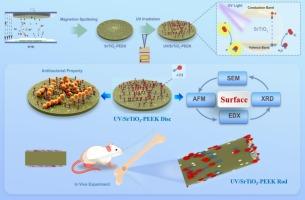光催化对聚醚-醚-酮类聚合物种植体抗菌性能及骨整合的影响
IF 4.7
3区 化学
Q2 CHEMISTRY, PHYSICAL
Journal of Photochemistry and Photobiology A-chemistry
Pub Date : 2025-09-12
DOI:10.1016/j.jphotochem.2025.116775
引用次数: 0
摘要
研究纳米级钛酸锶(SrTiO3)诱导的光催化和紫外线(UV) C光功能化对种植级聚合物聚醚醚酮(PEEK)抗菌性能和骨整合性能的影响。利用磁控溅射技术在PEEK样品表面制备了纳米级SrTiO3涂层。随后,光催化剂SrTiO3在UV-C光功能化诱导下进行了光催化反应。采用扫描电镜(SEM)、原子力显微镜(AFM)、x射线能谱(EDX)和x射线衍射(XRD)对样品进行了表征。采用平板菌落计数、细菌粘附观察、活菌/死菌染色等方法对戈氏链球菌进行抑菌试验。采用Wistar大鼠股骨种植体模型,采用显微ct和组织学方法评估体内骨整合情况。通过磁控溅射在PEEK表面构建100 nm厚度的SrTiO3光催化剂,改变样品的三维形貌,并在光催化剂涂层后将锶(Sr)和钛(Ti)元素引入PEEK表面。UV-C光官能化没有改变样品的三维形貌,但增加了样品的表面氧(O)含量,特别是光触媒涂层PEEK。此外,各基团的晶体结构没有变化。细菌实验表明,UV-C光功能化提高了PEEK的抗菌活性,SrTiO3光催化剂增强了UV-C光的改性性能。体内实验表明,在SrTiO3光催化剂和UV-C光功能化的协同作用下,种植体的骨整合效果最好。研究表明,纳米SrTiO3涂层和UV-C光功能化诱导的光催化作用提高了PEEK的体外抗菌活性和体内骨整合活性。本文章由计算机程序翻译,如有差异,请以英文原文为准。

Influence of Photocatalysis on antibacterial properties and Osseointegration of polymeric implant poly (ether–ether–ketone)
To investigate the influence of photocatalysis induced by nanoscale strontium titanate (SrTiO3) and ultraviolet (UV) C photofunctionalization on the antibacterial properties and osseointegration of implant-grade polymer poly (ether ether ketone) (PEEK). Magnetron sputtering was utilized to prepare a nanoscale SrTiO3 coating on the surface of PEEK specimens. Subsequently, the photocatalyst SrTiO3 performed a photocatalytic reaction under the induction of UV–C photofunctionalization. The specimens were characterized by scanning electron microscopy (SEM), atomic force microscopy (AFM), energy dispersive X–ray spectroscopy (EDX), and X–ray diffraction (XRD). The antibacterial properties were investigated by plate colony counting, bacterial adhesion observation, and live/dead bacteria staining for Streptococcus gordonii. In vivo osseointegration was evaluated by Micro-CT and histology using the Wistar rat femur implant model. One–hundred nm thickness SrTiO3 photocatalyst was constructed on PEEK after magnetron sputtering, the three–dimensional morphology of the specimens was changed, and strontium (Sr) and titanium (Ti) elements were introduced into the PEEK surface after photocatalyst coating. UV–C photofunctionalization did not change the three-dimensional morphology of specimens but increased their surface oxygen (O) content, especially photocatalyst coated PEEK. In addition, the crystal structure of each group did not change. Bacterial experiments showed that UV–C photofunctionalization improved the PEEK's antibacterial activity, and SrTiO3 photocatalyst amplified the modification performance of UV–C light. In vivo experiments demonstrated that under the synergistic effect of SrTiO3 photocatalyst and UV–C photofunctionalization, implants had the best osseointegration. This investigation indicated that photocatalysis induced by nano SrTiO3 coating and UV–C photofunctionalization elevated PEEK's antibacterial activity in vitro and osseointegration in vivo.
求助全文
通过发布文献求助,成功后即可免费获取论文全文。
去求助
来源期刊
CiteScore
7.90
自引率
7.00%
发文量
580
审稿时长
48 days
期刊介绍:
JPPA publishes the results of fundamental studies on all aspects of chemical phenomena induced by interactions between light and molecules/matter of all kinds.
All systems capable of being described at the molecular or integrated multimolecular level are appropriate for the journal. This includes all molecular chemical species as well as biomolecular, supramolecular, polymer and other macromolecular systems, as well as solid state photochemistry. In addition, the journal publishes studies of semiconductor and other photoactive organic and inorganic materials, photocatalysis (organic, inorganic, supramolecular and superconductor).
The scope includes condensed and gas phase photochemistry, as well as synchrotron radiation chemistry. A broad range of processes and techniques in photochemistry are covered such as light induced energy, electron and proton transfer; nonlinear photochemical behavior; mechanistic investigation of photochemical reactions and identification of the products of photochemical reactions; quantum yield determinations and measurements of rate constants for primary and secondary photochemical processes; steady-state and time-resolved emission, ultrafast spectroscopic methods, single molecule spectroscopy, time resolved X-ray diffraction, luminescence microscopy, and scattering spectroscopy applied to photochemistry. Papers in emerging and applied areas such as luminescent sensors, electroluminescence, solar energy conversion, atmospheric photochemistry, environmental remediation, and related photocatalytic chemistry are also welcome.

 求助内容:
求助内容: 应助结果提醒方式:
应助结果提醒方式:


